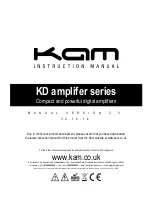
CALIBRATION AND REPAIR
18
BATTERY REPLACEMENT
After three to five years or about 1000
charge/discharge cycles, the sealed lead-
acid batteries degrade. When the battery
operation time shortens, or if the unit stays
very warm for more than a day after it is
plugged into the line, the batteries may
require replacement.
The three batteries are a standard size
which are available from several different
distributors. All are 12 VDC with a charge
capacity of about 2.0 Amp-hours, and
measure 7.02" X 1.33" X 2.38". Two of the
batteries are wired in parallel to provide the
high current required for the positive supply.
When replacing the batteries, take care to
observe the polarities!
FUSE REPLACEMENT
There are three fuses on the back panel of
the instrument. The fuse located inside the
power entry module will blow if the unit
draws excessive line current. Replace this
fuse with the value indicated for your line
voltage.
The other two fuses are in-line with the
batteries. These fuses will blow if the rear
panel ±12 VDC supplies are shorted, or if
the unit sources or draws excessive current
to or from the batteries.
NOISE CONTOURS
The noise contours (shown upper right) plot
the noise figure as a function of source
impedance and frequency. Noise Figure
(NF) is defined as:
•
NF = 20 log (Output noise / Gain X
Source Thermal Noise)
A low noise figure means that the output
noise is dominated by the thermal
(Johnson) noise of the source. A high noise
figure indicates that the amplifier's output
noise is dominated by the amplifier's own
noise, which is much larger than the thermal
noise of the source.
The NF gets worse for low source
resistances because the source's thermal
noise gets very small, while the amplifier's
input voltage noise stays relatively constant.
The NF gets worse for low frequencies and
low source resistances because the
amplifier's "1/f" noise is large relative to the
thermal noise of the source.
The NF gets worse for large source
impedances and high frequencies because
the signal is attenuated (hence the gain
reduced) by the shunting capacitance of the
input.
Under no circumstances will adding source
resistance reduce the amplifier's output
noise! While this does improve the NF, it
does so by making the source so noisy that
the amplifier is quiet in comparison.
Содержание SR560
Страница 2: ......
Страница 8: ...4...
Страница 10: ...SPECIFICATIONS 6...
Страница 26: ...APPENDIX A A 2...
Страница 30: ...APPENDIX B B 4...
Страница 44: ...SR560 COMPONENT PARTS LIST C 14...
















































